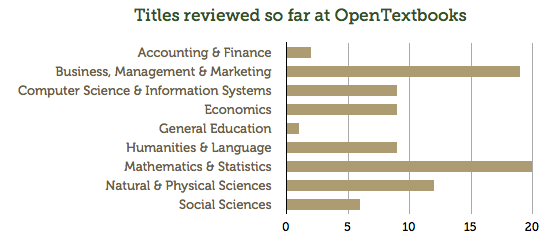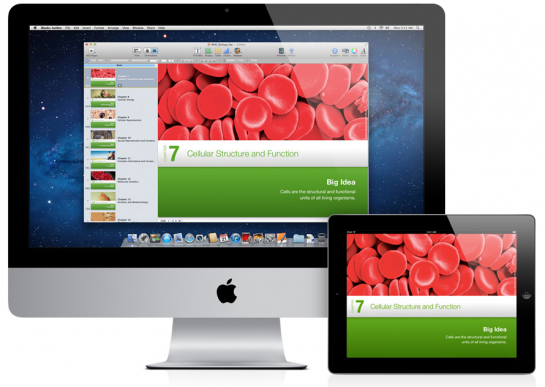Community Embraces New Word Game at Mid-Year Play Day This past Sunday, families at Takoma Park’s Seventh Annual Mid-Year Play Day had the opportunity to experience OtherWordly for the first time. Our educational language game drew curious children and parents to our table throughout the afternoon. Words in Space Several children gathered around our iPads […]
Read more Open textbooks are receiving a potential boost by an ambitious new, organized peer review project organized by the University of Minnesota. The average college student suffers with $1,000 or more in annual textbook costs; however, if more professors adopt open textbooks, higher education will become more affordable.
Open textbooks are receiving a potential boost by an ambitious new, organized peer review project organized by the University of Minnesota. The average college student suffers with $1,000 or more in annual textbook costs; however, if more professors adopt open textbooks, higher education will become more affordable.
The new “Open Textbooks” database hopes to get more facility to use affordable textbooks by helping them find good textbooks. The project has been public for three weeks, and currently has 87 book reviews.

These numbers should grow, as 11 Minnesota faculty members have offered to review books, and other Big Ten universities have talked about getting involved.
These kinds of independent catalogs are vital. Without the commercial incentives that drive commercial publishing, open textbooks are hampered by:
- Hard to find – With no profits to earn, open textbooks generally don’t invest in marketing. Nicolle Allen, textbook advocate for the Student Public Interest Research Group, said, “There are some sites that list reviews of open textbooks but I think this one is significant because it’s actually developed by a Big Ten, well-respected university.” Allen directs the research group’s Make Textbooks Affordable Project.
- No quality control – With no gatekeeper, there’s no barrier to entry and no commercial motivation to maintain the reputation of a publishing brand, employing editors and copyeditors.
- Unpredictable quality – With no sales royalties, authors must be internally motivated, and may not take the time to create superb publications.
- Minimal or no ancillary materials – The $4 billion commercial textbook industry often creates study plans, exams, and course-management software. Surveys show that instructors prize those materials above all else, said publishing industry analyst Al Greco of Fordham University.
![]() Open textbooks are complete textbooks released under a Creative Commons, or similar, license. Instructors can customize open textbooks to fit their course needs by remixing, editing, and adding their own content. Students can access free digital versions or purchase low-cost print copies of open textbooks.
Open textbooks are complete textbooks released under a Creative Commons, or similar, license. Instructors can customize open textbooks to fit their course needs by remixing, editing, and adding their own content. Students can access free digital versions or purchase low-cost print copies of open textbooks.
![]() Despite being free, open access textbooks have been slow to catch on, said David Ernst, who directs the new U. Minn. project at the academic and information technology department. Ernst said, “The open textbooks are out there… and they’re scattered.” Moreover, it’s hard for professors to assess the books because “they don’t know what is quality when they do find them.” By building up a peer-reviewed collection of textbooks, available to instructors anywhere, Minnesota officials hope to provide some of the same quality control that historically has come from publishers of traditional textbooks. University of Minnesota has the 11th highest enrollment of higher-ed institution in the U.S., with over 52k students.
Despite being free, open access textbooks have been slow to catch on, said David Ernst, who directs the new U. Minn. project at the academic and information technology department. Ernst said, “The open textbooks are out there… and they’re scattered.” Moreover, it’s hard for professors to assess the books because “they don’t know what is quality when they do find them.” By building up a peer-reviewed collection of textbooks, available to instructors anywhere, Minnesota officials hope to provide some of the same quality control that historically has come from publishers of traditional textbooks. University of Minnesota has the 11th highest enrollment of higher-ed institution in the U.S., with over 52k students.
“I became convinced this last year that we’re kind of at a tipping point right now,” Ernst said to InsideHigerEd. “It’s a thing that is going to be around and it’s only growing right now.
 In an effort to motivate professors, University of Minnesota faculty will be paid $500 to write a review of an open textbook, and will also earn the same amount to adopt such a book in class. Faculty from other institutions are also welcomed to write requests, but are not compensated.
In an effort to motivate professors, University of Minnesota faculty will be paid $500 to write a review of an open textbook, and will also earn the same amount to adopt such a book in class. Faculty from other institutions are also welcomed to write requests, but are not compensated.
 Currently, the majority of reviewed books are from Flat World Knowledge, a commercial publisher of free and open college textbooks.
Currently, the majority of reviewed books are from Flat World Knowledge, a commercial publisher of free and open college textbooks.
It’s unclear whether solving the findability problem will improve adoption. “While we’re told price is very important, it’s always fourth,” said Greco to MPR. “As of today, open access textbooks have very little traction in the business.”
The catalog includes texts from Rice University, which launched a series of peer-reviewed open access books earlier this year.
Other open textbooks initiatives have struggled. For example, the California set up an academic standards review for open textbooks, in an effort to cut back their K-12 textbook expenses, which were $350M in 2008. More recently, a California state senator sought $25M in state funds to create new open access textbooks.
![]() Ben Crowell is an open textbook author, says the K-12 market is even harder to convert to open access. “Textbook selection in K-12 education in the US tends to be extremely bureaucratic and top-down, and it’s virtually impossible to change that overnight, as Schwarzenegger tried to do [in California]. It’s completely different from higher education, where the assumption is that professors can choose whatever text they like as a matter of academic freedom. My experience is with writing free physics textbooks. They’re written for college students, but have also been adopted by a bunch of high schools. However, almost all of the high school adoptions have been from private schools, mainly Catholic schools.” Crowell teaches physics at Fullerton College, a community college in southern California, and runs Assayer, a catalog of free books.
Ben Crowell is an open textbook author, says the K-12 market is even harder to convert to open access. “Textbook selection in K-12 education in the US tends to be extremely bureaucratic and top-down, and it’s virtually impossible to change that overnight, as Schwarzenegger tried to do [in California]. It’s completely different from higher education, where the assumption is that professors can choose whatever text they like as a matter of academic freedom. My experience is with writing free physics textbooks. They’re written for college students, but have also been adopted by a bunch of high schools. However, almost all of the high school adoptions have been from private schools, mainly Catholic schools.” Crowell teaches physics at Fullerton College, a community college in southern California, and runs Assayer, a catalog of free books.
The open U. M. Textbook Catalog accepts books that are:
- Openly Licensed. Acceptable licenses include Creative Commons Attribution, Attribution-Share Alike and Attribution-Noncommercial-Share Alike or similar. Some books may fall under a No-Derivatives license if the publisher offers an adequate customization program.
- Complete. Only complete books, similar to traditional textbooks currently on the market, are included. Materials such as lecture notes, online courses, or drafts, are provided only as supplements to textbooks listed in the catalog.
- Suitable for Adoption Outside the Author’s Institution.
- Available in Print. Because most students still prefer print textbooks to digital, all textbooks include a print option, generally for $40 or less. In some cases, textbooks without a print-on-demand option may be included if they are sufficiently easy and inexpensive to print locally.
See the Open Academics textbook catalog, from the College of Education and Human Development (CEHD) at University of Minnesota. Go to site >>

Meanwhile, there are other important threads affecting the industry, such as Apple’s iBooks Author software, which is raising the profile and production quality of online texts, and will create a marketplace for finding and reviewing e-texts.


12 Sep 2012, 3:00 am
hey i came here by searching study the article .i have read this article its good.
14 Sep 2012, 8:35 am
i like this post .hank freid hank freid hank freid hank freid hank freid hank freid hank freid hank freid hank freid hank freid hank freid hank freid hank freid hank freid hank freid hank freid hank freid hank freid hank freid hank freid hank freid hank freid hank freid hank freid hank freid hank freid hank freid hank freid hank freid hank freid hank freid hank freid hank freid hank freid hank freid hank freid hank freid
14 Sep 2012, 8:37 am
i have read this article its good. hank freid hank freid hank freid hank freid hank freid hank freid hank freid hank freid hank freid hank freid hank freid hank freid hank freid hank freid hank freid hank freid hank freid hank freid hank freid hank freid hank freid hank freid hank freid hank freid hank freid hank freid hank freid hank freid hank freid hank freid hank freid hank freid hank freid hank freid hank freid hank freid hank freid hank freid hank freid hank freid hank freid hank freid